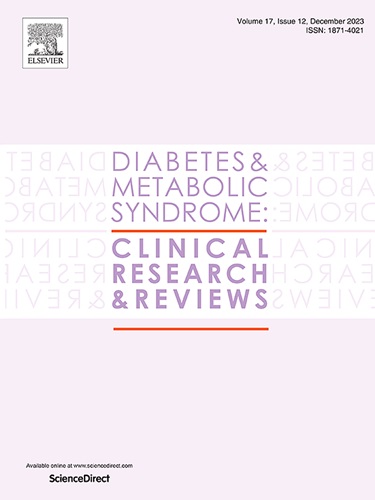Association between long-term fine particulate matter exposure and incident type 2 diabetes in a low-exposure Danish cohort: An AIRCARD analysis
IF 3.4
Q1 ENDOCRINOLOGY & METABOLISM
Diabetes & Metabolic Syndrome-Clinical Research & Reviews
Pub Date : 2025-08-01
DOI:10.1016/j.dsx.2025.103298
引用次数: 0
Abstract
Aim
The global burden of type 2 diabetes (T2D) continues to rise, with evidence suggesting that air pollution may contribute to its pathogenesis. This study examines the association between long-term exposure to fine particulate matter (PM2.5) and the risk of developing T2D in a cohort of older Danish men living in a low-exposure setting.
Methods
We conducted a prospective cohort study using 16,665 participants from the Viborg Vascular (VIVA) screening trial, aged 65–74 years without T2D at baseline. Residential PM2.5 was modeled with the DEHM/UBM/AIRGIS system from historical address data; road-traffic noise was estimated with Nord2000. Cox models with age as timescale evaluated time-varying PM2.5 exposure and T2D risk, adjusting for age, BMI, smoking status, socioeconomic factors, and traffic noise exposure.
Results
Over a mean 9.3-year follow-up, 324 participants (1.9 %) developed T2D. Incidence was lower than reported in prevention trials, reflecting differences in population risk and registry-based outcome capture. Participants who developed T2D had slightly higher long-term PM2.5 exposure compared to non-cases (12.12 vs 11.93 μg/m3; p < 0.001). Although absolute differences in exposure were small, they were consistent across the exposure distribution, suggesting a population-level effect even in a low-pollution environment. In adjusted time-varying Cox models, a 1.15 μg/m3 increment in PM2.5 was associated with a 30.6 % higher risk of T2D (HR 1.306, 95 % CI 1.08–1.58; p = 0.006). Associations were independent of body mass index, smoking, socioeconomic status, and traffic noise.
Conclusions
Long-term PM2.5 exposure was associated with T2D incidence in this cohort of older Danish men. Findings are hypothesis-generating, most applicable to low-to-moderate exposure settings, and should be interpreted with caution.
在低暴露的丹麦队列中,长期细颗粒物暴露与2型糖尿病之间的关系:一项AIRCARD分析
全球2型糖尿病(T2D)负担持续上升,有证据表明空气污染可能与其发病机制有关。本研究调查了长期暴露于细颗粒物(PM2.5)与低暴露环境中丹麦老年男性患T2D风险之间的关系。方法:我们对来自Viborg血管(VIVA)筛查试验的16,665名参与者进行了一项前瞻性队列研究,这些参与者年龄在65-74岁之间,基线时无T2D。利用DEHM/UBM/AIRGIS系统对历史地址数据进行住区PM2.5建模;道路交通噪音是用Nord2000估计的。以年龄为时间尺度的Cox模型评估了随时间变化的PM2.5暴露和T2D风险,调整了年龄、BMI、吸烟状况、社会经济因素和交通噪声暴露。结果在平均9.3年的随访中,324名参与者(1.9%)发生了T2D。发病率低于预防试验报告,反映了人群风险和基于登记的结果捕获的差异。患T2D的参与者与未患T2D的参与者相比,长期暴露在PM2.5中的比例略高(12.12 vs 11.93 μg/m3; p < 0.001)。虽然暴露的绝对差异很小,但它们在暴露分布中是一致的,这表明即使在低污染环境中也存在人群水平的影响。在调整后的时变Cox模型中,PM2.5浓度每增加1.15 μg/m3, T2D风险增加30.6% (HR 1.306, 95% CI 1.08-1.58; p = 0.006)。相关性与体重指数、吸烟、社会经济地位和交通噪音无关。结论:长期暴露于PM2.5与丹麦老年男性T2D发病率相关。研究结果是假设产生的,最适用于低至中等暴露环境,应谨慎解释。
本文章由计算机程序翻译,如有差异,请以英文原文为准。
求助全文
约1分钟内获得全文
求助全文
来源期刊

Diabetes & Metabolic Syndrome-Clinical Research & Reviews
ENDOCRINOLOGY & METABOLISM-
CiteScore
22.90
自引率
2.00%
发文量
248
审稿时长
51 days
期刊介绍:
Diabetes and Metabolic Syndrome: Clinical Research and Reviews is the official journal of DiabetesIndia. It aims to provide a global platform for healthcare professionals, diabetes educators, and other stakeholders to submit their research on diabetes care.
Types of Publications:
Diabetes and Metabolic Syndrome: Clinical Research and Reviews publishes peer-reviewed original articles, reviews, short communications, case reports, letters to the Editor, and expert comments. Reviews and mini-reviews are particularly welcomed for areas within endocrinology undergoing rapid changes.
 求助内容:
求助内容: 应助结果提醒方式:
应助结果提醒方式:


